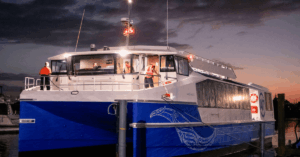Auckland’s First Fully Electric Passenger Ferry Hits The Water
Auckland has welcomed its first fully electric high-speed passenger ferry. Built by EV Maritime, the vessel entered the water on June 11, as it was slowly moved from the McMullen & Wing shipyard into the Tamaki River at Mt Wellington.
This is the first of two battery-electric ferries built under Auckland Transport’s low-emissions program. The ferries will undergo several technical checks in the coming weeks, followed by sea trials in the Hauraki Gulf to test their performance and automation systems.
EV Maritime’s CEO explained that after a month of river testing, the ferry will start charging at the newly installed charging station in Half Moon Bay. After this, wider sea trials will take place before the vessel is handed over to Auckland Transport for crew training and final commissioning.
According to Auckland Transport’s ferry program director, the ferries are mainly intended to serve the route between Half Moon Bay and downtown Auckland. However, they may occasionally operate to other areas like Devonport and Hobsonville Point.
The ferries are designed for mid-harbour routes, typically 30 to 45 minutes in duration. Each vessel has cost around $20 million, with about two-thirds of the funding provided by the New Zealand Government.
The remaining cost is shared between NZTA Waka Kotahi and Auckland Council. The director stated that multiple organisations have worked together to ensure the project’s success.
The construction of the ferries started in 2022, and they could enter service by the end of the year. However, Auckland Transport has not confirmed a commercial launch date yet. They stated that they want to ensure all testing and commissioning is complete before putting the vessels into regular service.
The electric ferry was designed by EV Maritime and uses propulsion technology developed by HamiltonJet, based in Christchurch. The hull is built from carbon-fibre composite, allowing for a maximum speed of 25 knots (46 km/h) and a capacity of 200 passengers.
There is also seating for 30 more people on the upper deck, with three restrooms on board, one of which is wheelchair accessible. Passengers will also have access to a small kiosk that serves barista-made coffee, beer, and wine.
Video Credits: Auckland Transport/YouTube
The ferry has a lifespan of over 30 years, while its batteries are expected to last around 10 years before needing replacement. Auckland Transport mentioned that they expect newer and better batteries to become available in the future as technology advances.
Charging for the vessel is expected to take place while passengers board and leave. It will only take 10 minutes to charge for a one-way trip. Each ferry is expected to operate eight return trips per day, requiring 16 charges daily.
The high-speed charger, rated at up to 3.3 megawatts, is 10 times faster than a Tesla supercharger, making it the first maritime use of the new CharIN Megawatt Charging System (MCS). The ferry has two MCS inlets rated at 1.1 megawatts each.
This ferry model is part of the new EVM200 class developed by EV Maritime. It is a battery-electric fast ferry with a 20-mile range, created specifically for urban public transport. The ferry is equipped with a low-drag, low-wash hull design developed in partnership with Emirates Team New Zealand, which helps it move efficiently at high speeds with minimal disturbance.
EV Maritime managed the full design, electrical system, and project delivery. Key components have been sourced internationally: batteries from Freudenberg (USA), motors and power electronics from Danfoss (Finland), waterjets from HamiltonJet (New Zealand), and automated PLC systems from Attest (New Zealand).
The director of McMullen & Wing shipyard said the launch was a proud moment that highlighted the strength of New Zealand’s shipbuilding and clean-tech capabilities. He acknowledged the collaborative work between designers, builders, and contractors that made the project possible.
EV Maritime’s CEO said that while electric ferries are becoming more common, fast passenger ferries like this one are still rare around the world. He added that this vessel could set a global benchmark for high-frequency electric ferry services. The use of the new megawatt charging standard adds to its global importance.
He also said this project is crucial to EV Maritime’s goal of building an export industry for electric ferries. He expressed gratitude to the government and Auckland Transport for backing the project and giving the company the chance to prove the technology in real-world conditions.
EV Maritime has already started expanding into international markets. In 2024, the company appointed a head for North American operations. Current projects include a hybrid-electric vessel for the Angel Island Tiburon Ferry in the San Francisco Bay Area, and a collaboration with AF Theriault for Halifax Regional Municipality in Canada.
Reference: rnz

